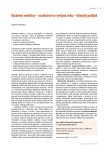The most frequent infectious complications in diabetic patients and their treatment
Authors:
Silvester Krčméry; Silvia Semanová; Marián Štrbák; Dominika Kocunová; Iveta Kováčová
Authors‘ workplace:
II. klinika geriatrie LFUK a UNsP Milosrdní bratia, Bratislava, prednosta doc. MUDr. Silvester Krčméry, CSc.
Published in:
Forum Diab 2015; 4(3): 181-183
Category:
Main Theme: Review
Overview
Infections in patients with diabetes mellitus occur more frequently and their course is more serious. Sensitivity is increased by immunity functions disorders, glycosuria, blood supply disorders in the region of adrenal medulla and papillae, as well as by the loss of renal functions in consequence of diabetic nephropathy. The acute pyelonephritis is more frequently complicated in diabetic patients with urosepsis, renal abscess and papillary necrosis. Infectious diseases are also a frequent cause of metabolic decompensation of diabetes, hyperosmolar and ketoacidotic coma. With regard to the accumulation of the above described and further complicating factors, it is needed to also treat asymptomatic bacteriuria in diabetic patients (almost general consensus of opinion).
Key words:
dermatological infections – gastrointestinal infections – hepatobiliary infections – respiratory tract infections – urogenital infections
Sources
1. Muller LM, Gorter KJ, Hak E et al. Increased risk of common infections in patients with type 1 and type 2 diabetes mellitus. Clin Infect Dis 2005; 41(3): 281–288.
2. Peleg AY, Weerarathna T, McCarthy JS et al. Common infections in diabetes: Pathogenesis, management and relationship to glycaemic control. Diabetes Metab Res Rev 2007; 23(1): 3–13.
3. Geerlings SE, Hoepelman AI. Immune dysfunction in patients with diabetes mellitus (DM). FEMS Immunol Med Microbiol 1999; 26(3–4): 256–265.
4. Price CL, Al Hassi HO, English NR et al. Methylglyoxal modulates immune responses: relevance to diabetes. J Cell Mol Med 2010; 14(6B): 1806–1815.
5. Nirmal J, Caputo GM, Weitekamp MR et al. Infections in patients with diabetes mellitus. N Engl J Med 1999; 341(25): 1906–1912.
6. Miller AC, Subranian RA, Safi F et al. Influenza A 2009 (H1N1) virus in admitted and critically ill patients. J Intensive Care Med 2011; 27(1): 25–31.
7. Jain S, Kamimoto L, Bramley AM et al. Hospitalized patients with 2009 H1N1 influenza in the United States, April-June 2009. N Engl J Med 2009; 361(20): 1935–1944.
8. Restrepo BI, Camerlin AJ, Rahbar MH et al. Cross-sectional assessment reveals high diabetes prevalence among newly-diagnosed tuberculosis cases. Bull World Health Organ 2011; 89(5): 352–359.
9. Dooley KE, Chaisson RE. Tuberculosis and diabetes mellitus: Convergence of two epidemics. Lancet Infect Dis 2009; 9(12): 737–746.
10. Geerlings SE. Urinary tract infections in patients with diabetes mellitus: Epidemiology, pathogenesis and treatment. Int J Antimicrob Agents 2008;31(Suppl 1): S54–S57.
11. Ludwig E. Urinary tract infections in diabetes mellitus. Orv Hetil 2008; 149(13): 597–600.
12. Chen SL, Jackson SL, Boyko EJ. Diabetes mellitus and urinary tract infection: epidemiology, pathogenesis and proposed studies in animal models. J Urol 2009; 182(6 Suppl): S51–S56.
13. Jadoon NA, Shahzad MA, Yaqoob R et al. Seroprevalence of hepatitis C in type 2 diabetes: Evidence for a positive association. Virol J 2010; 7 : 304. Dostupné z DOI: <http://dx.doi.org/10.1186/1743–422X-7–304>.
14. Elhawary EI, Mahmoud GF, El-Daly MA et al. Association of UVV with diabetes mellitus: an Egyptian case-control study. Virol J 2011; 8 : 367. Dostupné z DOI: <http://dx.doi.org/10.1186/1743–422X-8–367>.
15. Nicolau DP, Stein GE. Therapeutic options for diabetic foot infections: a review with an emphasis on tissue penetration characteristics. J Am Podiatr Med Assoc 2010; 100(1): 52–63.
16. Powlson AS, Coll AP. The treatment of diabetic foot infections. J Antimicrob Chemother 2010; 65(Suppl 3): iii3–iii9. Dostupné z DOI: <http://dx.doi.org/ 10.1093/jac/dkq299>.
17. Calvet HM, Yoshikawa TT. Infections in diabetes. Infect Dis Clin North Am 2001; 15(2): 407–421.
18. Shimizu T, Tokuda Y. Necrotizing fasciitis. Intern Med J 2010; 49(12): 1051–1057.
Labels
Diabetology Endocrinology Internal medicineArticle was published in
Forum Diabetologicum

2015 Issue 3
Most read in this issue
- A view on the cardiorenal syndrome
- The most frequent infectious complications in diabetic patients and their treatment
- Incidence of diabetic nephropathy in a population of patients with diabetes mellitus in Slovakia: results of the NEFRITI investigation
- Early screening and treatment slow the progression of diabetic nephropathy
